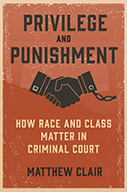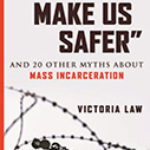Privilege and Punishment: How Race and Class Matter in Criminal Court

Author: Matthew Clair
Publisher: Princeton University Press, 2020. 320 pages
Reviewer: April D. Fernandes ǀ November 2021
Scholarship on racial disparities in criminal legal system outcomes is fraught with queries into how race-based animus, bias, and neglect enter into court processes and procedures. These factors result in the increased presence of people of color in courtrooms (Hinton et al., 2018), higher likelihoods of conviction and incarceration (Ulmer et al., 2016), and longer sentences (Steffensmeier, 1998; Ulmer, 2012). In Privilege and Punishment: How Race and Class Matter in Criminal Court, Dr. Matthew Clair provides nuance to this conversation, exploring criminal courts in Boston and focusing on the intricate ways that race and class intersect during interactions within the criminal legal system. While race has become a fixture in work on the American legal system, class is often assumed or considered to be an aside in analyses. Clair, however, shows that the interplay between race and class reveals insights into differentials in plea deals, trial outcomes, and levels of investment, constructing privilege through an interactional lens. Clair finds that individuals’ interactions with court agents, specifically attorneys, whether private or public defenders, and patterns of withdrawal or compliance, are central to understanding the multiplicity of ways that race and class enter into the courtroom space.
Through detailed interviews and courtroom observations, Privilege and Punishment unpacks the complexity of race- and class-based disparities by centering the narrative on the opposing responses of delegation and withdrawal and the attendant system of rewards and punishments utilized by court agents. Set within this era of expansive social controls and mass criminalization, the book explores how broader forces and histories of alienation and disadvantage aid in patterning interactions with courts, resulting in consequences that further entrench inequalities between the disadvantaged and the privileged. Compliance with and deference to an attorney was rewarded, resulting in more favorable case results and increased investment in the individual and their case. In contrast, withdrawal and resistance were met with frustration and attorneys’ parallel response of withdrawal. For disadvantaged clients, withdrawal, whether in the form of resignation or resistance, offers a window into the scope, weight, and consequences of these interactions. While existing work suggests that individuals in economically precarious positions often employ deference in interactions with authority figures, Clair upends the class-linked patterns associated with these interactions, with the economically privileged in his analysis deferring to the expertise of their attorneys, while those without financial resources engage in resistance or resignation in attempting to participate directly in their own defense or withdrawing altogether. Flipping the narrative and expectations of these interactions results in a disruption, a rift in the staid and routine operations of the court, resulting in sanctions for those who transgress or privileges for those who stay within the boundaries of compliance. For Clair, this is where inequality enters in: these interactions are used in determinations of worthiness and deservingness and are indelibly linked to the intersections between race and class, with attorneys withdrawing from clients who resist their advisement or who upend the routine ordering of court proceedings. In his analysis, Clair pivots to suggest that effective representation is not a sufficient condition to ameliorate unequal and unjust legal results as long as assessments of worthiness begin and end with curtailing the needs and agency of disadvantaged individuals in the courtroom.
Clair’s work extends and augments existing literature while being firmly rooted within foundational scholarship on court organization (Cover, 1983; Merry, 1990; Tyler, 1988) and, most notably, the established work on the ways that people who traverse the legal system experience the courts, delving into complex dynamics between court agents and clients (Kohler-Hausmann, 2018; Gonzalez van Cleve, 2016; Natapoff, 2018). His work harkens back to law scholars whose research questions ask: “who is the law for?” and “what is justice?” with an eye towards how these determinations are influenced by racial and class identifications. Privilege and Punishment adds to the growing intersectional literature on legal system spaces by expanding beyond a racial understanding of disparities within court outcomes to address class and how the intersection between race and class identities aids in subsuming the needs of disadvantaged clients of color in service of maintaining the supremacy of court order and authority.
An interesting thread that weaves its way through Clair’s work is the divergence in the needs and desires of defendants and courts. These differences show up in the ways that defendants choose to engage in legal process, the strategies they urge their attorneys to employ, and their choices to disconnect from legal wrangling when it does not suit their hopes for a just outcome. Clair’s work is littered with examples of defendants seeking an outcome that diverges from the structures and processes of the court system. The need to express themselves freely, to engage directly in their own defense, to seek redress within their own definitions of justice, and to pursue outcomes that are in direct opposition to those sought by their attorneys are the ways in which defendants in Clair’s book, especially people of color from economically marginalized backgrounds, attempt to assert their place within systems of control. With their own direct and vicarious encounters with the legal system, defendants attempt to infuse their lived experiences into the defense of their cases, to the chagrin and frustration of their attorneys and, often, judges. The system makes no space for the words of defendants, besides the sanctioned utterances of guilt or innocence, with the court operating on the age-old adage “speak only when spoken to.” The refusal of economically disadvantaged defendants of color to silence themselves and to suppress their frustration with an inherently unjust and racist system creates conflict and schisms, influencing central relationships with the courts and its agents as well as the conclusions of cases. These forms of resistance and of envisioning justice beyond the bounds of what is offered in the courtroom are key to imagining the structure and process of systems and institutions that might truly be focused on justice.
In his work, Clair does not witness widespread overt racism or classism in interactions between clients and attorneys or attorneys and judges. Rather, Clair suggests that we expand our definition of discrimination to include the adjudication and judgment of how a defendant acts, their levels of resistance or withdrawal, and their compliance with the authority of the court. Clair sees vast differentials based on race and class in how defendants relate to their attorneys, to the court proceedings, and to their role within them. In the concluding chapter, Clair asserts that the court should be more mindful not just of the racial and class dynamics within the courtroom, but of the broader race- and class-based inequalities that exist within society and how these inequalities are part and parcel of why people enter into the system in the first place: “It is ironic that a social institution ostensibly meant to ensure justice in our society seeks instead to avoid accounting for the injustices that bring people in contact with it and that influence the way people are able to navigate its halls” (p. 185). The court does not exist within a vacuum; it is surrounded and permeated by racial and class context, which is consequential in its processes, procedures, and outcomes. Clair deftly reveals this disconnect in the interactions between clients and attorneys through the silencing that occurs within courtrooms and the withdrawal that typifies a suitable response to an unjust and unequal system.
The intersection of race and class provides a necessary and vital extension of existing work on courtroom dynamics and disparate outcomes. It also indicates that there are avenues not explored that are ripe for further investigation. While interactions with authority figures are known to be patterned by race and class, but existing literature also suggests that these dynamics are complicated by other intersecting identities, such as gender and disability (Richie, 2012; Davis, 2016; Steele and Thomas, 2014). Clair acknowledges at the outset of his book that the role and process of the law is gendered, but that this is beyond the scope of his work. The methods of entrance, the modes of interactions, and the attendant consequences of legal system contact for women of color or individuals with disabilities are essential pieces of investigations of social control in the courtroom space. The exploration of the historical and contemporary vestiges of racialized, gendered, and ableist systems and institutions can produce a more comprehensive understanding of and transformative insights into the nature and scope of legal inequality, exclusion, and erasure. For future scholars, opening up these lines of inquiry will add to the complexity behind these interactions and their attendant outcomes, offering a rich and nuanced intersectional narrative.
At the conclusion of his book, Clair offers suggestions to ameliorate, change, and disassemble unjust legal systems and to provide space for the words, experiences, and resistance of disadvantaged individuals. The solutions are numerous but remain focused on altering the current state of privilege predicated on defendants’ levels of compliance and deference and mired within historical and contemporary legacies of race and class inequities. Clair provides multiple entry points for shifting these narratives, with offerings for practitioners, scholars, and activists alike. Clair’s work in Privilege and Punishment is a solid foundation upon which to extend our collective understanding of the compounded nature of system inequality in court systems, the varied and pervasive ways it exists and persists, and potential next steps to address it.
References:
Cover, R. M. 1983. Foreword: Nomos and Narrative. Harvard Law Review. 97(4): 4–68.
Davis, L. J (Ed.). 2016. The Disability Studies Reader. London, UK: Routledge.
Hinton, E., Henderson, L. & Reed, C. 2018. An Unjust Burden: The Disparate Treatment of Black Americans in the Criminal Justice System. Vera Institute of Justice. Retrieved from https://www.vera.org/downloads/publications/for-the-record-unjust-burden-racial-disparities.pdf.
Merry, S. E. 1990. Getting Justice and Getting Even: Legal Consciousness Among Working-Class Americans. Chicago, IL: University of Chicago Press.
Natapoff, A. 2018. Punishment Without Crime: How Our Massive Misdemeanor System Traps the Innocent and Makes America More Unequal. New York, NY: Basic Books.
Richie, B. E. 2012. Arrested Justice. New York, NY: New York University Press.
Steele, L. & Thomas, S. 2014. Disability at the Periphery: Legal Theory, Disability, and Criminal Law. Griffith Law Review. 23(3): 357–69.
Steffensmeier, D., Ulmer, J. & Kramer, J. 1998. The Interaction of Race, Gender, and Age in Criminal Sentencing: The Punishment Cost of Being Young, Black, and Male. Criminology. 36(4): 763–98.
Tyler, T. R. 1988. What is Procedural Justice?: Criteria Used by Citizens to Assess the Fairness of Legal Procedures. Law & Society Review. 22: 103–36.
Ulmer, J. T. 2012. Recent Developments and New Directions in Sentencing Research. Justice Quarterly. 29(1): 1-40.
Ulmer, J., Painter-Davis, N. & Tinik, L. 2016. Disproportional Imprisonment of Black and Hispanic Males: Sentencing Discretion, Processing Outcomes, and Policy Structures. Justice Quarterly. 33(4): 642–81.
April D. Fernandes, Assistant Professor, Department of Sociology and Anthropology, North Carolina State University


